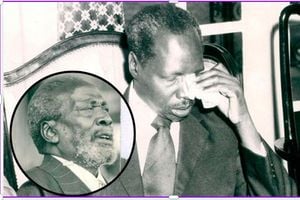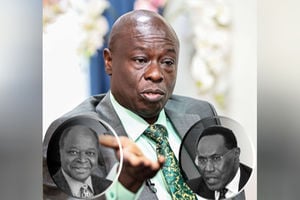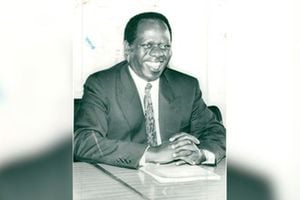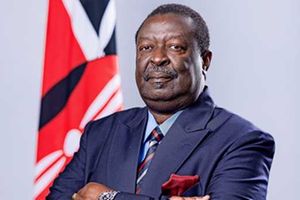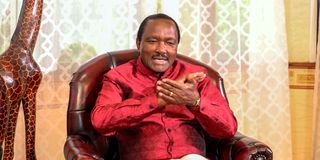
Wiper party leader Kalonzo Musyoka during an interview at his home in Nairobi on December 30, 2023.
As Kenya teetered on the brink of collapse amid the violent aftermath of the 2007 election, Stephen Kalonzo Musyoka unexpectedly rose as Mwai Kibaki’s choice for vice president. But rather than calm the storm of ethnic clashes, his appointment only intensified the flames of anger and division. Never before had a VP been appointed to balance the sinking Ark. Raila Odinga’s camp, convinced that Kibaki had rigged the polls and had no intention of stepping down or offering them a seat in government, saw Kalonzo’s elevation as the final insult. As a soft target, they went for him.
Kalonzo’s promotion was a calculated move. While it gave Kibaki’s government a veneer of stability and legitimacy, it simultaneously shattered the fragile power-sharing negotiations that international mediators were desperately trying to salvage. In the fiercely contested election, Kalonzo’s ODM-Kenya party had finished third, a position of influence capable of shifting the political tide. But by accepting the vice presidency, Kalonzo found himself in the eye of a political storm. He was now in alliance with the very forces he had once opposed.
After voting at his rural home in Tseikuru, Kalonzo had opted to stay there as lawyer Mutula Kilonzo and a team of ODM-K strategists kept vigil at the Kenyatta International Convention Centre, tracking the electoral process. Safe in Tseikuru, Kalonzo had no inkling that his political journey was only just beginning. Soon, he would be thrust deeper into a political turbulence he could not escape.
Amidst the swirling chaos of a nation in crisis, a phone call came. It was from State House, Nairobi. On the other end was Stanley Murage, Kibaki’s trusted strategist. The counting of votes was still underway, but the Kibaki camp had made its decision: Kalonzo Musyoka was the man they needed. Murage’s voice carried the weight of a delicate proposition. “The Kibaki team is keen to work with you,” he said, extending an olive branch. It was an invitation to the government as Kibaki’s side suffered heavy losses in parliamentary strength. State House asked whether they should send an aircraft to pick Kalonzo but his advisers told him to first watch the numbers.
Having been betrayed by the very political brokers behind this offer, Kalonzo was hesitant. The bitter aftertaste of the broken Memorandum of Understanding from the Narc era still haunted him. Trust, shattered before, and in the political terrain, was not easily mended. But as Kibaki was declared the winner of the fiercely disputed election, and the country descended into violent turmoil, the urgency of the moment found Kalonzo at the heart of a new political tempest. Both Kibaki and Raila Odinga sent emissaries, each vying for his influence. They wanted him to choose a side.
Initially, Kalonzo chose neutrality and travelled by road to Nairobi as international peace brokers descended to the city. In a tense meeting at the Serena Hotel with John Kufuor, the head of the Commonwealth Observer Group, Kalonzo declared that his party would not take sides in the brewing conflict. But as the flames of ethnic violence spread unchecked across the nation, neutrality became an untenable position. The weight of the country’s fate pressed heavily upon him. Before Kufuor could even make his full case, Kibaki’s appeal grew stronger. Kalonzo picked his side and agreed to take his place in the government.
When he finally agreed to negotiate, he entrusted Johnson Muthama and David Musila with hammering out the Cabinet positions. On the other side, Kibaki had selected Amos Kimunya and John Michuki. The negotiations unfolded in the halls of Michuki’s Windsor Golf and Country Club. Also present were Martha Karua and Mutula Kilonzo, tasked with drafting the coalition agreement. Kalonzo’s acceptance of the vice presidential role placed him at the heart of an unfolding political drama, assuming office at a time when government institutions were strained, and the future of the nation hung precariously in the balance.
During the campaign, Kalonzo had often left his rivals puzzled with a cryptic promise: “Nitapita katikati yao”-- “I will pass between them.” And true to his word, he deftly manoeuvred through the stormy political landscape, securing his place as Kenya’s vice president, before Odinga could negotiate.
Kalonzo’s appointment sent ripples through the political establishment. Although Kibaki extended an invitation to Raila Odinga for talks at State House, Nairobi, Odinga’s ODM saw it as an underhanded tactic. To them, accepting the invitation would signify tacit recognition of Kibaki as the legitimate Head of State, something they were unwilling to concede. Odinga dismissed the overture as “public relations gimmickry,” claiming that Kibaki was merely attempting to undermine international mediation efforts. Instead, he called for three days of anti-government protests in 30 locations, demanding Kibaki’s resignation and the handover of power to him.
Read: Kalonzo Musyoka faces big political test after Ruto, Raila Cabinet deal
The next level of negotiation was between Odinga and Kibaki’s side. The atmosphere in the Orchid Room at Serena Hotel, where key meetings were held, was always thick with tension. From the very beginning, shouting matches broke out. “You stole the election!” William Ruto would bellow across the room, only to be met with an equally forceful retort from Martha Karua: “We didn’t steal!”
By the time the Grand Coalition Government was finally brokered in the Orchid Room at Serena Hotel by Kofi Annan, and the agreement signed by Kibaki and Odinga on the steps of Harambee House, Musyoka had already secured his place in the corridors of power. Odinga assumed his newly created role as prime minister, and after six weeks of intense horse-trading over every ministerial detail, Kibaki unveiled the new 42-member coalition government on April 13, 2008.
The Grand Coalition Government was a delicate balance of pro-Kibaki and pro-Odinga members, with each side getting equal representation. Musyoka remained vice president, Odinga took up the prime minister’s post, while Musalia Mudavadi from ODM and Uhuru Kenyatta from PNU were appointed deputy prime ministers. To satisfy every interest and ethnic group, new ministries had to be created, resulting in the largest Cabinet Kenya had seen since independence.
But then came a thorny issue that only Head of Civil Service Francis Muthaura could resolve: the matter of the pecking order. According to the National Accord, the prime minister was to chair all Cabinet committee meetings and answer questions in Parliament. Yet, when Kibaki appointed Musyoka as Leader of Government Business shortly after the Accord took effect, Odinga challenged the decision, writing to House Speaker Kenneth Marende to appoint him to the same role. At the same time, President Kibaki also wrote to Marende, confirming Kalonzo as Leader of Government Business.
The conflicting claims led to a stalemate that threatened to paralyse parliamentary operations. Odinga’s ODM argued that, as a principal partner in the Grand Coalition, the Leader of Government Business should be an ODM member, while Kibaki’s PNU alliance contended that the position traditionally belonged to the vice president.
These were some of the battles that Kalonzo had to fight. In April 2009, Speaker Marende delivered a ruling that temporarily resolved the impasse by appointing himself as chairman of the House Business Committee and assigning the joint government chief whips to manage parliamentary affairs in the meantime. He then threw the ball back to Kibaki and Raila to settle the dispute themselves.
“It is a sad day for me as I listened to the Speaker’s ruling,” Kalonzo told journalists, adding, “We even went ahead to violate our own rules.”
Behind the scenes, Mutula Kilonzo had written to Muthaura, seeking clarification on the functions of each office. Muthaura responded by asserting that the prime minister was in charge of government business, while the vice president handled State matters, including succession in the event of the President’s death. While this resolved the protocol dispute, it did little to ease the animosity between the Raila and Kalonzo factions. From within, Odinga’s camp continued to challenge Kibaki’s government, leading to frequent paralysis and tension in the coalition.
Odinga had leveraged ODM’s superior numbers in Parliament, further solidifying his grip on power within the fragile Grand Coalition Government. In this delicate balance of power between Kibaki and Odinga, Kalonzo found himself relegated to a distant third, a mere pawn in a high-stakes game of political chess. Odinga wielded considerable influence, while Kalonzo was left to navigate the treacherous waters of a middle ground where his title as vice president masked the fact that his real power was limited. His critics derisively called him “Watermelon,” a symbol of his perceived vacillation between political forces.
As the International Criminal Court (ICC) investigated the Kenyan cases, Musyoka was cast as Kenya’s “shuttle diplomat,” a role that took him from capital to capital, pleading the nation’s case. While this diplomatic portfolio earned him international respect and visibility, it was often seen by his critics as a move by Kibaki to sideline him from domestic affairs. However, this role afforded him a measure of international stature that Odinga had long struggled to attain.
Kalonzo’s political career, built on a foundation of diplomacy and careful alliances, was a testament to his ability to navigate the treacherous corridors of power. Though he had a cordial relationship with President Kibaki, his dealings with Raila were fraught with tension. In a strange twist of political irony, Kalonzo would later find himself backing Odinga’s bid for the presidency—a man who complicated his tenure during their time in the Grand Coalition Government.
More than anyone else, Kalonzo Musyoka offered Mwai Kibaki a sense of stability in his final term.
@Johnkamau1
Tomorrow: William Ruto: The scheming prayer warrior
In case you missed it, here are the other captivating stories on the curse of the deputies.

